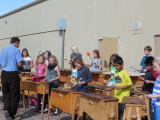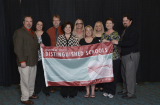-
Category 1
Selected in 2013
-
Grades: pre k - 6
School Setting: rural
Town Population: 3
Student Enrollment: 406
Student Demographics:
Black/African American: 1%
Teacher/Student Ratio: 1:25
White/Caucasian: 79%
Hispanic: 16%
Hawaiian/Pacific Islander: 0%
Asian: 1%
Native American: 2%
Other: 1%
% Reduced Lunch: 43%
% ELL Learners: 22%
Founded: 1950 -
PRINCIPAL:
Cole Young -
CONTACT:
2750 S. Corral Street
Humboldt, AZ 86329
928-759-4400
cole.young@humboldtunified.com
Humboldt Elementary School
Humboldt, AZ
Our infrastructure is one of setting goals, monitoring them, challenging them, and conquering them with higher expectations for every student. Our educational framework is laden with levels of motivation and support.
- Describe specific programs in place to ensure that families are involved in the success of your school and students.
- We host our Title One family meeting and discuss the various programs we use to assist their child in the skills used to read. We also explain our assessment system and what the data given to them means. Lastly, parents are given strategies to help assist their child at home, specifically related to their child’s instructional needs. Our 5 aides and teacher focus in on a child’s success through a small differentiated/skill group setting, peer partner learning, paired reading, book talks, computer-assisted reading, drill and practice through sight word/phrase practice, guided and assisted reading, and reader’s theater. This is done using the following programs: Kindergarten Peer Assisted Learning Program (KPALS), Peer Assisted Learning Program (PALS), Spalding, Scott Foresman Early Reading Intervention, Reading Counts Enterprise Edition, LETRS Timed Readings, Basic Skill Builders, Lexia Reading, Read Naturally, Phonics for Readers, AIM for Reading, and Dolch Words and Fry Words.
- Describe the most successful activity your school has initiated to strengthen ties to your community.
- Our Panda Booster Club has parents, teachers, students, and community organizations working hand-in-hand supporting the student achievement initiatives of our school. Our District offers courses on Love and Logic to parents, encouraging their participation in the school, making that home-to-school connection. We partner with the Foster Grandparent program from NAU to help in our kindergarten rooms. We have a large influence in our small community. Partnering with the town, community center, local businesses and service organizations only makes sense. Bringing lots of vested people together to work on an initiative for the school, brings valuable resources and builds bonds of support. Without the parents, community, service organizations, and families we are a stand-alone entity providing a service, not the dynamic educational literacy center that ensures the well-being of each and every child that comes to our campus.
- Describe your philosophy of school change or improvement.
- School improvement is a process of reflection and filled with courageous conversations about who you are as a school. We are always looking to refine who we are, what we do, and how we do it through child-centered decision making. Change is truly the only thing we can count on when it comes to education and its many changing views and policies. The staff at HES embraces change and is not afraid to answer the difficult questions concerning our school and how it relates to the best interest of our students. We have been recently accredited through the AdvancEd International accreditation process. This process included reflecting upon instruction, leadership, data management, communication, stakeholder feedback our facility, etc… It was process where we rejoiced in the areas we do well, but took a serious look at and developed a plan of action to items we need to strengthen. To improve is to raise expectations of ourselves and school. We ask of it of our students; why not us?
- What are your school’s top two goals for the next year?
- We have two goals, as a school, we are working on when it comes to serving our students. Through surveys, internal communication among staff and through our S.I.T.E. and Booster Club meetings we are focusing our energies collectively on increasing parent involvement/engagement and strengthening and aligning our current math curriculum to that of the College and Career Standards. This alignment would include the radical change of our current pacing guides, progress monitoring of students, and reinforcing the inductive learning process, as it relates to discovery in mathematics.
- What is the single most important factor in the success of your school that others could replicate?
- Student success through achievement and supported through motivation is built into our culture at HES. We work our tails off every day for one reason: to provide every student an opportunity to shine. Our infrastructure is one of setting goals, monitoring them, challenging them, and conquering them with higher expectations for every student. Our educational framework is laden with levels of motivation and support. Students set goals as they embark on a trajectory to earn the opportunity to be amongst the top readers in the school and country. We assess and reward students who show growth. This applies to both our best readers and those making measureable gains towards their individualized goals. For this motivational framework to be successful, it takes a staff that supports our mission, monitors students’ achievement, provides differentiated/skill specific instruction, an effective Title 1 program, parental support, and a dedication of making every student ‘our’ student.
- Describe the program or initiative that has had the greatest positive effect on student achievement, including closing achievement or opportunity gaps, if applicable.
- As a school, we realized that without having a quality systemic assessment system, we could not diagnostically target students for intervention nor track student progress. The ‘guess and hope’ system was like playing darts in the dark. Occasionally we hit the target; however, most of the time it took multiple attempts before honing in on what we were looking for, taking far too much time. Furthermore, even if we did have an authentic assessment, we needed to know more about how and what to do with the information/data gleaned. Tier one intervention in the classroom has become our mainstay when it comes to student achievement. We then provide levels of progress monitors and ‘look-fors ‘when it comes to the growth of each of our students. Our Intervention Team then meets with each teacher every 6 weeks who have identified their ever-changing ‘Fab 5’ and we go to work. The team then collaboratively works to identify, diagnose, plan, prescribe, monitor and exit all students we see.
- Explain how Title I funds are used to support your improvement efforts.
- 5. Title 1 funds are precious. We believe, as a staff, that human capital stretches our dollar and provides highly qualified adults in classrooms to assist our kids in small group settings. We feel programs/books end up sitting on shelves collecting dust. Computer programs are nice, but have a hard time teaching when a student runs into a problem! However, there is no replacement for the power of relationship and trust when it comes to people! We use our funding to find the best people to work with our students every day in small group Tier Two and/or Tier Three environments. Only then do we know where our students are performing and are able to adapt to their individual instructional needs. This information is collected then shared amongst the 'village' and systemically we can all assist to make a huge difference in closing a child's achievement gap. Regardless of how the educational pendulum swings, people adjust and make an immediate and significant impact on a child's life!
- Identify the critical professional development activities you use to improve teaching and student learning.
- Professional Development is ever changing and on-going as we try and meet the needs of the students whom all have varying abilities and attend HES. As research uncovers effective reading strategies in assisting our students’ ability to be more adept readers, it is our job to keep abreast of the information and be ready for implementation. We have had extensive training by the State in the areas of Response to Intervention (RTI). This training has brought to light the importance and significance of high-quality instructional practices in both classrooms and throughout a child’s exposure to small-group intervention times. Our Para pros all have had extensive training in the areas of implementation of effective instruction using the researched-based programs used in both the Title One room and our Reading Lab. The importance of this professional development has our aides and teachers using the corrective materials both consistently and with fidelity.
- Describe how data is used to improve student achievement and inform decision making.
- Professional Development in the area of student growth data has been a big push on our campus. As a campus, we have identified students, looked at their growth, found root cause, assigned skill groups, progress monitored, and adjusted as outcomes and goals are realized. Taken a step further, we have also talked in PD sessions concerning how to increase growth for all of our students using multiple points of data, including Galileo. This software has been a big undertaking, but has focused our efforts on students, their particular needs and what we need to do in response to their current performance. By looking at the data and reflecting on our teaching abilities dictates the specific needs we have as a staff and the need our students. We continue to offer PD in the areas of the writing process, data, interpretation of assessment, reading strategies, small group instruction, action plans, etc…
- Describe your school culture and explain changes you’ve taken to improve it.
- Our success has everything to do with our staff and their uncompromising efforts to serve the students of our community. Everyone that works at HES brings something unique to each child’s educational experience; however, all staff share a common bound, high expectations. Our teachers and staff have every opportunity to make an excuse why our students can’t learn, but they don’t. We make no excuses and hold ourselves to the level we expect from our students. There is never a challenge neither too big nor small when it has to do with the students at HES. We are a focused group of highly qualified, effective instructors who band together to accomplish what most would think the impossible. Every student we have is a Humboldt Panda, under the care and watchful eye of every adult on campus! All students will achieve… no exceptions!
Stats
-
Category 1
Selected in 2013
-
Grades: pre k - 6
School Setting: rural
Town Population: 3
Student Enrollment: 406
Student Demographics:
Black/African American: 1%
Teacher/Student Ratio: 1:25
White/Caucasian: 79%
Hispanic: 16%
Hawaiian/Pacific Islander: 0%
Asian: 1%
Native American: 2%
Other: 1%
% Reduced Lunch: 43%
% ELL Learners: 22%
Founded: 1950 -
PRINCIPAL:
Cole Young -
CONTACT:
2750 S. Corral Street
Humboldt, AZ 86329
928-759-4400
cole.young@humboldtunified.com











